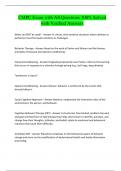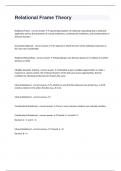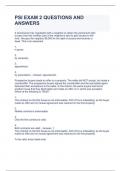CMPC Exam with All Questions 100% Solved
with Verified Answers
When can SFBT be used? - Answer In critical, time-sensitive situations where athletes or
performer must find quick solutions to challenges
Behavior Therapy - Answer Based on the work of Pavlov and Skinner and the famous
principles of classical and operant conditioning.
Classical Conditioning - Answer Originally proposed by Ivan Pavlov, refers to the learning
that occurs in response to a stimulus through pairing (e.g., bell rings, dog salivates).
"beethoven is classic"
Operant Conditioning - Answer Skinner: behavior is reinforced by the events that
directly follow it.
Social Cognitive Approach - Answer Bandura: emphasized the interactive roles of the
environment, the person, and behavior.
Cognitive Behavior Therapy (CBT) - Answer A structured, time-limited, problem-focused,
and goal-oriented form of talk therapy that helps clients learn to identify, question, and
change how their thoughts, attitudes, and beliefs relate to emotional and behavioral
reactions that cause them difficulty.
2nd Wave CBT - Answer Placed less emphasis on the behavioral aspect of behavior
change and more on the modification of dysfunctional beliefs and faulty information
processing.
,3rd Wave CBT - Answer Prioritizes psychological and behavioral processes facilitating
health and well-being, rather than the reduction of psychological and emotional
symptoms.
CBT Techniques - Answer Relaxation training: progressive muscle relaxation, meditation,
and breathing retraining
Exposure therapy: imaginal or in vivo exposure, including flooding and implosive
therapy
Behavior rehearsal: behavioral training in social skills, habit reversal, or problem solving
Cognitive restructuring: strategies to identify and alter maladaptive thought processes
Operant procedures: manipulation of reinforcers or punishers, including behavioral
activation
Rational Emotive Behavior Therapy - Answer Albert Ellis (grandfather of CBT):
Individuals contribute to their own psychological problems through the often rigid and
irrational beliefs they hold about themselves, events, and situations.
Aim of REBT - Answer Help clients dispute their irrational beliefs and "minimize their
emotional disturbances and self-defeating behaviors by acquiring a more realistic,
workable, and compassionate philosophy of life."
What framework guides REBT? - Answer ABC: Activating agent, irrational belief,
emotional/behavioral consequence, dispute belief, effective philosophy developed, new
feeling
,Mindfulness-Based Therapy - Answer Mindfulness is defined as "the awareness that
emerges through paying attention on purpose, in the present moment, and non-
judgmentally, to the unfolding experience moment to moment.
Mindfulness-Based Stress Reduction (MBSR) - Answer An eight-week group intervention
program that consists of formal mindfulness practices, such as the body scan, mindful
yoga, and sitting meditation, as well as informal mindfulness practices to reduce stress.
Acceptance and Commitment Therapy (ACT) - Answer This mindset prevents
experiential avoidance (i.e., avoiding or getting rid of unpleasant internal experiences)
and cognitive fusion (i.e., attaching thoughts and feelings to an experience to the point
that they dominate behavior and diminish flexibility).
ACT Hexaflex - Answer Acceptance, cognitive defusion, contact with present moment,
self as context, values, and committed action.
ACT: Acceptance - Answer Giving oneself permission to experience (rather than fight)
difficult feelings, emotions, sensations, and impulses just as they are.
ACT: Cognitive Defusion - Answer Involves distancing oneself from unhelpful thoughts,
feelings, memories, and images - by learning to defuse thoughts, negative thoughts have
much less impact and influence.
ACT: Contact with Present Moment - Answer Involves bringing full awareness to here-
and-now experiences, with interest and receptiveness.
ACT: Self as Context - Answer The aspect of the self that remains aware of what one is
experiencing (i.e., doing, thinking, feeling) in the moment.
, ACT: Values - Answer Reflect what is significant and meaningful in one's life (e.g.,
relationships with others) and the type of person one wants to be.
ACT: Committed Action - Answer Engagement in behavior that is reflective of one's
values.
Compassion-Focused Therapy (CFT) - Answer Helps individuals develop more affiliative
feelings toward themselves, along with a more compassionate inner voice. Compassion
is encouraged through caring behaviors and expressing and communicating feelings of
warmth and safety.
DBT: Stage 1 - Answer The focus is safety and stabilization. The goal is for clients to
achieve some control over problematic behaviors (safety).
DBT: Stage 2 - Answer Behaviors are more stable and traumatic experiences are safely
explored. The goal is for clients to experience their emotional pain instead of silencing
or burying it (exploration).
DBT: Stage 3 - Answer Focuses on enhancing quality of life through maintenance of
progress and goal setting. The aim is to nurture joy, self-efficacy, and happiness
(change).
DBT: Stage 4 - Answer Emphasizes improving learned skills or working toward spiritual
fulfillment. The goal is to help clients achieve and maintain an ongoing capacity for
happiness and success (progress/improvement).
Systems Theory - Answer The aim of systems therapy is to help members of a system
(i.e., group) gain insight into how each member's role within the system may affect its
functionality.






